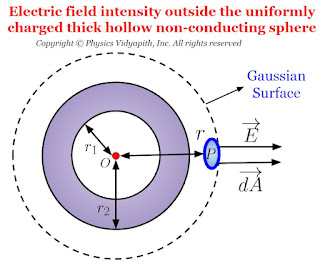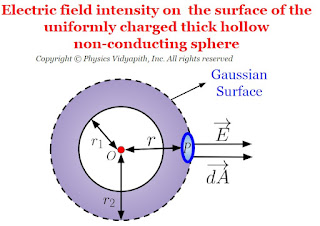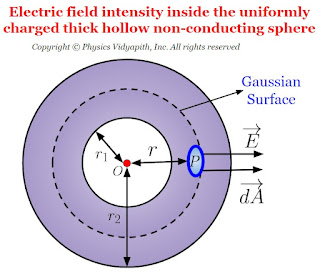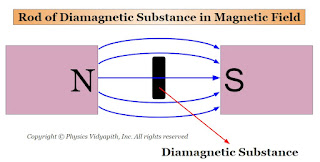In electromagnetic waves, the electric field vector and magnetic field vector are mutually perpendicular to each other (Proof)
The general solution of the wave equation for the electric field vector and magnetic field vector are respectively given below
$\overrightarrow{E}= E_{\circ} e^{i(\overrightarrow{k}. \overrightarrow{r} - \omega t)} \qquad(1)$
$\overrightarrow{B}= B_{\circ} e^{i(\overrightarrow{k}. \overrightarrow{r} - \omega t)} \qquad(2)$
Here $E_{\circ}$ and $B_{\circ}$ are the complex amplitude of electric field vector $\overrightarrow{E}$ and magnetic field vector $\overrightarrow{B}$ respectively and $\overrightarrow{k}$ is the propagation constant.
Now
$\overrightarrow{\nabla} \times \overrightarrow{E}= \left( \hat{i} \frac{\partial}{\partial x} + \hat{i} \frac{\partial}{\partial x} +\hat{i} \frac{\partial}{\partial x} \right). \left( \hat{i}E_{x} + \hat{j}E_{y} + \hat{k}E_{z} \right) $
$\overrightarrow{\nabla} \times \overrightarrow{E} = \begin{vmatrix}
\hat{i} & \hat{j} & \hat{k} \\
\frac{\partial}{\partial x} & \frac{\partial}{\partial y} & \frac{\partial}{\partial z} \\
E_{x} & E_{y} & E_{z} \\
\end{vmatrix}$
$\overrightarrow{\nabla} \times \overrightarrow{E} = \hat{i} \left[ \frac{\partial E_{z}}{\partial y} -\frac{\partial E_{y}}{\partial z} \right] - \hat{j} \left[ \frac{\partial E_{z}}{\partial x} -\frac{\partial E_{x}}{\partial z} \right] + \hat{k} \left[ \frac{\partial E_{y}}{\partial x} -\frac{\partial E_{x}}{\partial y } \right] \qquad(3)$
Here $E_{x}$, $E_{y}$ and $E_{z}$ are the component of electric field vector $\overrightarrow{E}$ in $x$, $y$, and $z$ direction. So the component form of the equation $(1)$
$\overrightarrow{E_{x}}= E_{\circ x} e^{i(\overrightarrow{k}. \overrightarrow{r} - \omega t)}$
$\overrightarrow{E_{y}}= E_{\circ y} e^{i(\overrightarrow{k}. \overrightarrow{r} - \omega t)}$
$\overrightarrow{E_{z}}= E_{\circ z} e^{i(\overrightarrow{k}. \overrightarrow{r} - \omega t)}$
We know that:
$\overrightarrow{k}.\overrightarrow{r}=\left( \hat{i}k_{x} + \hat{j}k_{y} + \hat{k}k_{z} \right). \left( \hat{i}x + \hat{j}y +\hat{k}z \right)$
$\overrightarrow{k}.\overrightarrow{r}=x k_{x} + yk_{y} + zk_{z} $
So above equation can be written as:
$\overrightarrow{E_{x}}= E_{\circ x} e^{[i(x k_{x} + yk_{y} + zk_{z}) - \omega t)]} \qquad(4)$
$\overrightarrow{E_{y}}= E_{\circ y} e^{[i(x k_{x} + yk_{y} + zk_{z}) - \omega t)]} \qquad(5)$
$\overrightarrow{E_{z}}= E_{\circ z} e^{[i(x k_{x} + yk_{y} + zk_{z}) - \omega t)]} \qquad(6)$
Now find that derivative from the equation $(4)$, equation $(5)$, and equation $(6)$ then substitute these values in equation $(3)$, So we get
$\left[ \frac{\partial E_{z}}{\partial y} -\frac{\partial E_{y}}{\partial z} \right] = \frac{\partial E_{z}}{\partial y} - \frac{\partial E_{y}}{\partial z} $
$\left[ \frac{\partial E_{z}}{\partial y} -\frac{\partial E_{y}}{\partial z} \right] = \frac{\partial}{\partial y} \left( E_{\circ z} e^{[i(x k_{x} + yk_{y} + zk_{z}) - \omega t)]} \right) -\frac{\partial}{\partial z} \left( E_{\circ y} e^{[i(x k_{x} + yk_{y} + zk_{z}) - \omega t)]} \right) $
$\left[ \frac{\partial E_{z}}{\partial y} -\frac{\partial E_{y}}{\partial z} \right] = \left(i k_{y} E_{z} - i k_{z} E_{y} \right) $
$\left[ \frac{\partial E_{z}}{\partial y} -\frac{\partial E_{y}}{\partial z} \right] = i \left( k_{y} E_{z} - k_{z} E_{y} \right) \qquad(7)$
Similarly
$\left[ \frac{\partial E_{z}}{\partial x} -\frac{\partial E_{x}}{\partial z} \right] = i \left( k_{x} E_{z} - k_{z} E_{x} \right) \qquad(8)$
$\left[ \frac{\partial E_{y}}{\partial x} -\frac{\partial E_{x}}{\partial y} \right] = i \left( k_{x} E_{y} - k_{y} E_{x} \right) \qquad(9)$
Now substitute the value of equation $(7)$, equation $(8)$, and equation $(9)$ in equation $(3)$
$\overrightarrow{\nabla} \times \overrightarrow{E} = i \left[\hat{i} \left( k_{y} E_{z} - k_{z} E_{y} \right) - \hat{j} \left( k_{x} E_{z} - k_{z} E_{x} \right) _ \hat{k} \left( k_{x} E_{y} - k_{y} E_{x} \right) \right]$
$\overrightarrow{\nabla} \times \overrightarrow{E} = i \begin{vmatrix}
\hat{i} & \hat{j} & \hat{k} \\
k_{x} & k_{y} & k_{z} \\
E_{x} & E_{y} & E_{z} \\
\end{vmatrix}$
$\overrightarrow{\nabla} \times \overrightarrow{E} = i \left( \overrightarrow{k} \times \overrightarrow{E} \right) \qquad(10)$
According to Maxwell's third equation
$\overrightarrow{\nabla} \times \overrightarrow{E}= - \frac{\partial \overrightarrow{B}}{\partial t}$
$\overrightarrow{\nabla} \times \overrightarrow{E}= - \frac{\partial}{\partial t} \left( B_{\circ} e^{i(\overrightarrow{k}. \overrightarrow{r} - \omega t)} \right) \quad \left\{From \: equation \: (2)\right\}$
$\overrightarrow{\nabla} \times \overrightarrow{E}= i \omega \overrightarrow{B} \qquad(11)$
From equation $(10)$ and equation $(11)$
$i \left( \overrightarrow{k} \times \overrightarrow{E} \right) = i \omega \overrightarrow{B}$
$ \left( \overrightarrow{k} \times \overrightarrow{E} \right) = \omega \overrightarrow{B} \qquad(12)$
$\therefore$ Magnetic field vector $(\overrightarrow{B})$ is perpendicular to both electric field vector $(\overrightarrow{E})$ and propagation of wave vector $(\overrightarrow{k})$.
Similarly, from $\overrightarrow{\nabla} \times \overrightarrow{B}$, we get
$ \left( \overrightarrow{k} \times \overrightarrow{B} \right) = -\frac{\omega}{c} \overrightarrow{E} \qquad(13)$
Thus, In an electromagnetic wave, the electric field and magnetic field vector are perpendicular to each other and also to the direction of propagation of the wave.











